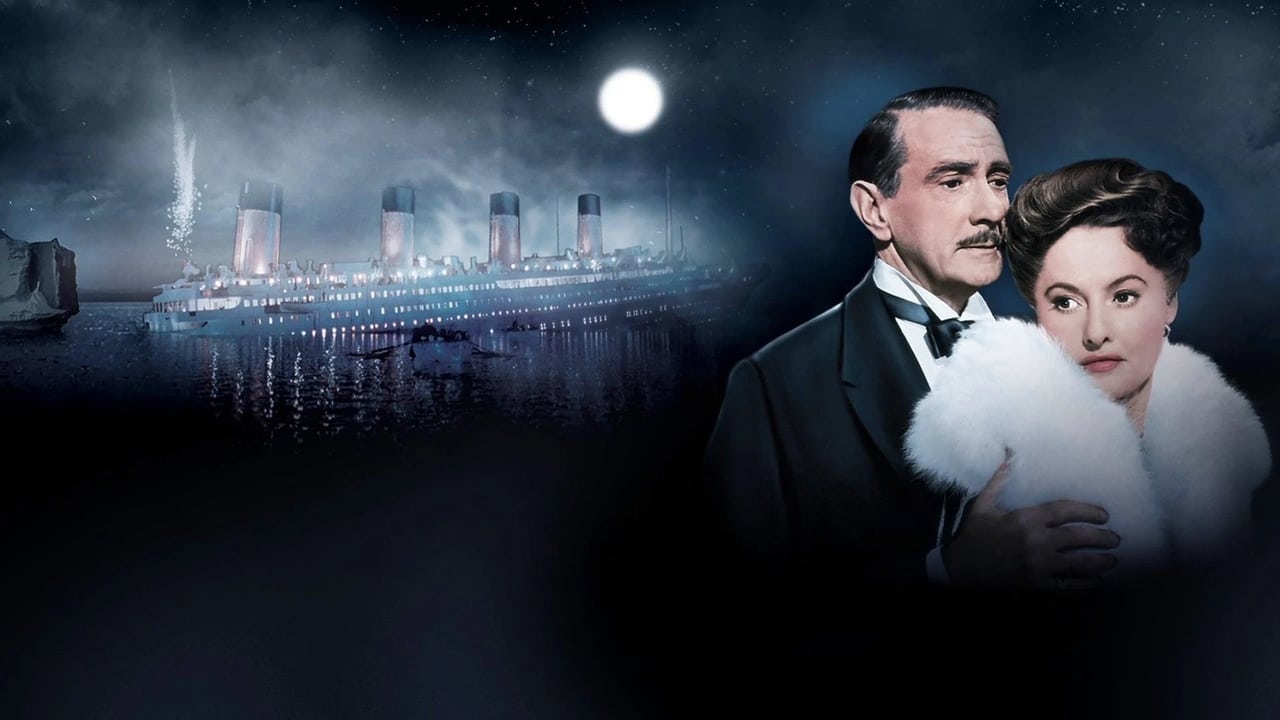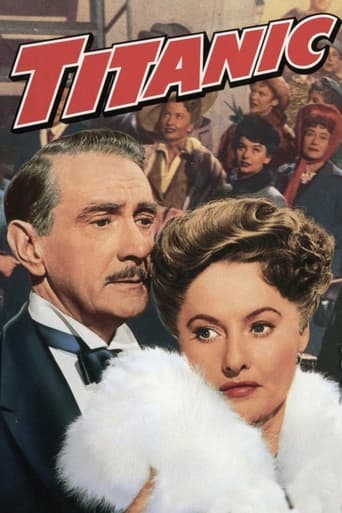

Such a frustrating disappointment
... View MoreGood , But It Is Overrated By Some
... View MoreSimple and well acted, it has tension enough to knot the stomach.
... View MoreThe movie's not perfect, but it sticks the landing of its message. It was engaging - thrilling at times - and I personally thought it was a great time.
... View MoreIn director Jean Negulesco's 1953 version of Titanic, Clifton Webb plays an affluent man brimming with confidence and as we soon see, a touch of arrogance. He believes their children should continue to be raised in Europe, and his wife (Barbara Stanwyck) believes they should return to America to get a taste of more humble surroundings. The two are at odds with another, and it culminates in the film's best scene, her informing him that their boy is not his son, and then walking off with the door slowly closing. The scene later where she describes how it happened, and the frostiness of his reaction, is sad and chilling. We admire Webb's certainty and his understanding of just what to do in social situations, and we recoil in horror at the coldness of his feelings, and his disdain for the common man. He's an iceberg, on a ship destined to hit an iceberg.Another nice moment is when Barbara Stanwyck reads the poem 'When I Was One-and-Twenty" by A.E. Housman to a young man played by Robert Wagner. Unfortunately, Wagner's character isn't all that likeable. He has a few comments to Stanwyck's daughter (Audrey Dalton) that may make you smile, such as "Never heard it before? Where have you been, locked up in some art gallery? Why, that's the hottest jig the kids do." However, he also has some musical performances between the 60 and 70 minute points of the film (pre-iceberg) that don't have the intended endearing effect, including a cringe-inducing performance of the "Navajo Rag", about how they dance down on the ol' reservation. Richard Basehart is strong in his supporting role of priest who we find out has been defrocked because of his drinking, and his scene with Stanwyck on the deck at night, each lost in their own troubles, is a good one. However, the performance seems a bit wasted, as there's nowhere for the character to go, and the film ends up choosing a path high in schmaltz. Unenviable comparisons to other Titanic movies aside (in particular Cameron's), the film fails most post-iceberg. Some of the right elements are there, including the hubris of a foolhardy increase in speed in order to impress the world in the first place, and the lack of enough lifeboats. The special effects are relatively brief but reasonably good for the time period. And of course, the moment is poignant, being a true story, and fate being so arbitrary. Stanwyck is said to have cried on set imagining the horror. Perhaps one of the ways people have of coping with this is to create heroic characters. In this version, it just gets to be a little much, and the stories between Webb and Stanwyck, their little boy, Basehart, and Wagner all seem false. Similar accusations are leveled at other movies that I sometimes find myself defending, but I can't in this case, or at least, as much. It's an average movie, certainly watchable, but dated and without balance in the fictional part of its story.
... View More. . . that with a whimper. This TITANIC of 1953 certainly provides viewers with plenty of Big Bangs, unlike the whimper fest of James Cameron's infamous 1997 TITANIC bladder-buster. Cameron's hatchet job makes the Billionaire Class out to be the bad guys, as they scuttle around the sinking vessel shooting at each other with guns! Jean Negulesco's 1953 TITANIC, on the other hand, is surely more realistic, depicting--as it does--the rush of Monied Men down to steerage to carry the shell-shocked poor immigrant women and children to the safety of lifeboats. These wealthy role models of the Fox Corporation Film Studio's 1953 TITANIC outing teach their sons that if they're old enough to wear long pants, they're old enough to surrender their life boat seat to the odd woman out. Barbara Stanwyck's character in the 1953 TITANIC hails from the century-long GOP stronghold of Michigan's Mackinac Island, won hands-down by Leader Trump in 2016. This 1953 TITANIC suggests that had the 20 richest Americans supporting Trump sailed on the TITANIC, he would have seen his entire Cabinet go down with the ship. (If Michigan's Betsy DeVos had orange hair, this would remind me of a certain Eurhythmics song.)
... View MoreIt may seem hard to believe today, but three films were made about the Titanic within six months of its sinking on April 15, 1912. Of course, all were silent films and shorts. The first was made just 29 days after the incident. "Saved from the Titanic" was a 10-minute short that featured a young actress, Dorothy Gibson, who survived the sinking. A 30-minute German film followed on Aug. 17, and a 23-minute French film came out in October.By 1929, sound films were being made, but this 1953 film was the first full-length Hollywood feature set on and about the Titanic. Even with some musicals, other films, and very good docudramas that followed well into the 21st century, the 1953 "Titanic" remains one of the best and most enjoyed films. That's because, unlike most films that have looked for the cause and the details of the disaster, "Titanic" is more about people. It's focus is on one family, a few other individuals, and some of the crew who just happen to be on the maiden voyage of the world's largest and most luxurious ship.We see the ship as it leaves Southampton, England on April 10, 1929; then when it stops near Cherbourg, France, and then at Queenstown (present day Cobh), Ireland. At each stop it takes on passengers. When it heads toward the open sea, it has about 1,300 passengers and a crew and staff of about 920 plus. A lot of things are at play in the inability to determine precisely the number of people on board the ship. An Encyclopedia Britannica article explains that in detail.Then, the film hones in on the Sturges family, around whom the rest of the drama unfolds. Clifton Webb plays Richard Ward Sturges, Barbara Stanwyck is his wife, Julia. The Sturges children are Annette (played by Audrey Dalton) and Norman, played by an uncredited Harper Carter. Other major characters we see are Gifford Rogers, played by Robert Wagner; and Thelma Ritter as Maude Young, Richard Basehart as George Healey, and Brian Aherne as Captain E.J. Smith. A number of actors play smaller parts, mostly of prominent people or key figures. Thus, we encounter John Jacob Astor and his wife, First Officer Murdock, Chief Officer Wilde, Isador and Ida Strauss, Benjamin Guggenheim, and Second Officer Lightroller.What we are treated to in this film, is a drama of life that takes place on board a huge ocean liner; and then the excitement, fear, worry, and tense scrambling to survive a disaster at sea. All of the cast perform it superbly.I have enjoyed all of the five or six films about the Titanic that I have seen. Each has its own special appeal and value. But this film, made just 40 years after the event, has a greater feel of reality. It may be in the more natural ease of early 1950s manners, customs, style, talk and peoples' looks to mimic those of the earlier period. The people in more recent films set in a more distant time are further removed from the culture and society. So, they don't seem as natural or real, but more like people in a play or movie.The beauty of this film is that one can fit in and feel as though you are a passenger on board the Titanic with the Sturges family and others. This is a wonderful drama on the high seas, before and during a disaster.
... View MoreCompelling, excellent version of the tragedy. While there was much to like in the more recent version I've always found this one to be the superior of the two. Clifton Webb and Barbara Stanwyck are perfectly cast as a wealthy couple whose marriage is disintegrating. They seem completely natural in their surroundings and their performances could not be bettered. The love story is sweet and unlike the newer version makes sense since both characters are from the same class, the only way in that era that they would mingle, class division was too ingrained at the time for people to move freely about the ship. A dolled up Thelma Ritter is a hoot as the unsinkable Molly Brown even though she is called Maude Young here. Not as technically sophisticated as the James Cameron version but much more emotionally resonant.
... View More